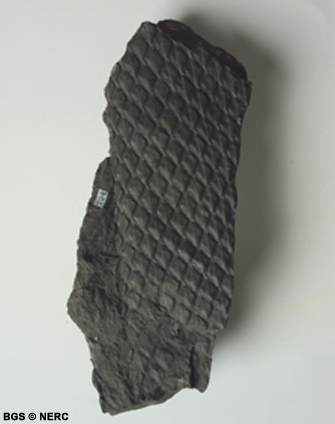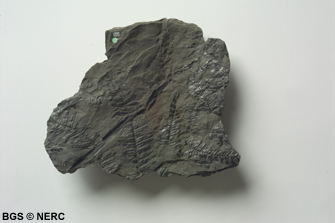
Minerals and mines
Introduction | History
of lead mining | History
of zinc mining | Lead
ore & mines
Zinc ore & mines | Iron
ore, ochre & mines | Coal mining
Coal mining

Coal is a sedimentary rock made up of organic carbon. In the Mendips, the coal is made from the remains of fossil plants that existed during the late Carboniferous, 300 million years ago. During this time, a series of large river deltas extended across the region. These deltas deposited the Quartzitic Sandstone and the Coal Measures, a thick series of deltaic sandstones, and mudstones. In these deltas, large areas of swampy tropical forest grew and died. The remains of the forests have been preserved as thin coal seams which have exquisitely preserved fossil plants and insects in places. These thin coal seams, often less than a metre thick, are sandwiched in between the thick layers of dark grey deltaic mudstone, often with fossil plant remains, and some coarser red sandstone beds.
The Coal Measures crop out in the Nettlebridge valley, where they are occasionally are exposed in stream gullies and along the banks of the Mells River. The rocks here are severely folded and contorted as a result of mountain building processes which occurred around 250 million years ago.

The soft Coal Measures mudstone have been folded so much they are now vertical, and in some places overturned.
Because of the folding, the techniques used to mine the thin seams of coal are more akin to those used in the Cornish tin mines or the lead mines elsewhere on Mendip rather than the coalfields of south Wales or northern England.
- Home
- Overview maps
- Locality
areas
- Cheddar Gorge
- Charterhouse
- Blackdown
- Burrington Combe
- Shipham & Rowberrow
- Crook Peak & Axbridge
- Banwell to Churchill
- Priddy
- Harptree & Smitham Hill
- Draycott & Westbury-sub-Mendip
- Wookey Hole & Ebbor Gorge
- Wells
- Great Elm & Vallis Vale
- Mells & the Wadbury Valley
- The Vobster area
- The Whatley area
- Torr Works & Asham Wood
- Beacon Hill
- Stoke St Michael & Oakhill
- Holwell & Nunney
- Shepton Mallet & Maesbury
- Gurney Slade & Emborough
- The Nettlebridge valley
- Geology
- Minerals and mines
- Quarrying
- Caves and karst
- Biodiversity
- Detailed site information
- Acknowledgements
- External links
- Search
- Site map